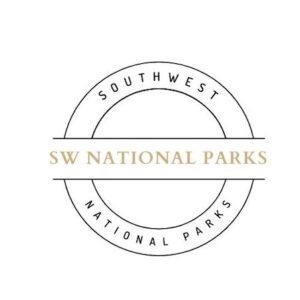Tips for Visiting Yellowstone in September
Yellowstone National Park is especially beautiful in September. Summer crowds start to thin out, giving you a true chance for privacy and spectacular wildlife viewing.

The best reason to visit in September is to avoid the crowds. The official end of summer tourists is September, therefore there are far fewer people in the park.
In addition, by the end of the month, the fall colors are in full bloom. The Park is mostly made up of lodgepole pines, which don’t change color with the seasons, but there are pockets of aspen trees scattered throughout. Their vivid yellow leaves gleam in the sunlight and are a delight for autumn visitors.
September is the mating season for many wildlife species. Elk migrate north for the rut, which takes place in places like Mammoth Hot Springs and the Madison River. Bull elk can be seen defending and battling for their harem, and their bugling can be heard reverberating off the peaks. Bull bison can be spotted performing the same thing in the Hayden and Lamar Valleys.
Yellowstone Weather in September
Yellowstone’s weather in September is unpredictable, with warm days and frigid nights. Mammoth Hot Springs has an average temperature of 68 degrees Fahrenheit and a low of 39 degrees Fahrenheit.
The average temperature in Yellowstone Lake is 61 degrees Fahrenheit with a low of 31 degrees Fahrenheit. In September, it rains on average 5 days.
Temperatures often drop by 5-6 degrees in late September. Highs in the 70°F (20°C) range are still possible during the day, while lows dip to around 39°F (5°C) at night.
Thank you for supporting this website written by an American. This post may contain affiliate links. This means I earn a small commission on these links at no extra cost to you.
National Park Entrance Fees
To enter the National Parks, you’ll need to pay an entrance fee or have a National Parks Pass also known as American the Beautiful Pass.
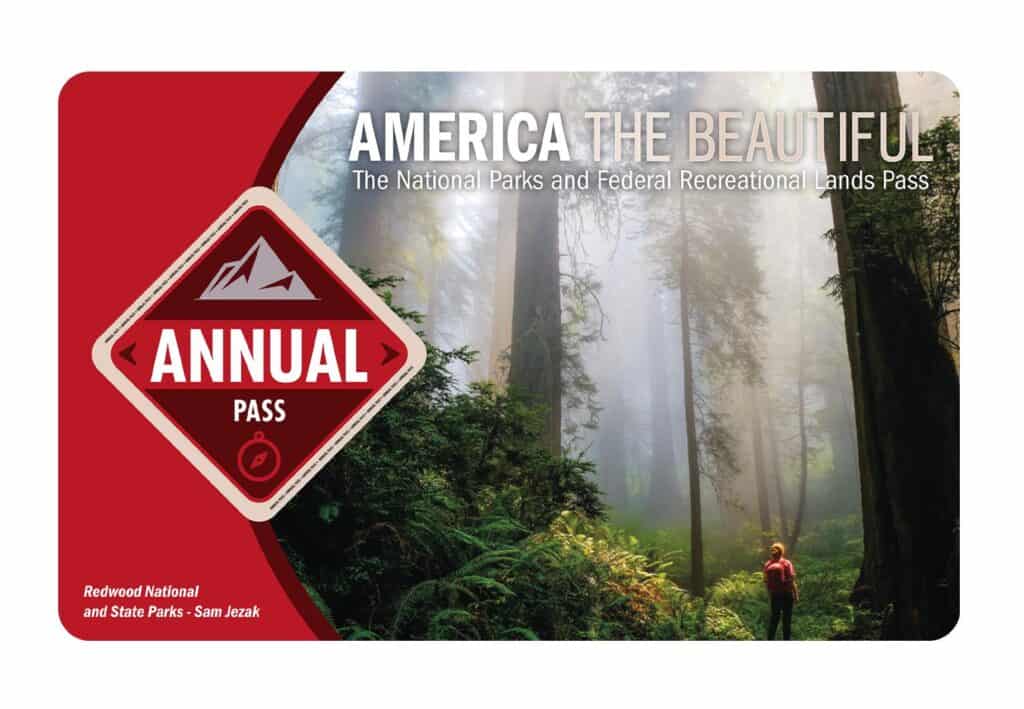
It costs $80 for a yearly America the Beautiful Pass. This gives you access to all national parks and federal areas that charge fees. The America the Beautiful Pass is well worth it!
I purchased my first one in 2016 and it’s such a money-saver! Plus 10% of sale proceeds go to the National Park Foundation.
Tips for Visiting Grand Teton National Park
Grand Canyon National Park is perfect for outdoor enthusiasts. There is something for everyone on this list and for different fitness levels. Also, note that it is dry and hot (in the summer), and make sure you know what you are getting into before you start. Here are a few tips for visiting the Grand Canyon:
- Bring a reusable water bottle and lots of water! Remember you are in the sun and you will need to drink lots of water. I love my LifeStraw Filtered Water Bottle. I can refill this bottle anywhere and it comes with a carabiner to connect it to my daypack.
- Check the Weather – days over 100 degrees are very common. Make sure to check.
- Hiking boots or sandals that will protect your feet! I love good shoes. I need all the support and help I can get. I actually love these sandals for hiking and also love these hiking boots.
- Bring hiking poles for balance and to protect your knees. I know many experienced hikers (and even amateur ones) think that hiking poles are for old people who lose their balance. Actually, hiking poles can help when going down steep inclines or when scrambling over rocks. They are great to hike with even for the most experienced hiker.
- Wear a sunhat. I feel like this whole post is about how high you are in the mountains and how much closer you are to the sun but it is so true. At elevation, you are closer to the sun and more likely to burn. Wear sun protection such as a sun hat and sunscreen.
- Be aware of the wildlife. This is the Southwest and you will need to watch out for snakes and other wildlife such as moose or a bear. Please stay away from wildlife and do not feed them. I recommend carrying bear spray as well.
- Start Early – If you want to avoid the traffic and the heat you will need to start your hike early. That way it will be nice and cool and the smog will not affect you either.
- Leave no trace. If you are new to the concept of Leave No Trace it is all about preserving the environment to ensure it is in the same or better condition when you leave it. This means that you should stick to the trails and carry out everything that you carried in. This is a great explanation of the Leave No Trace principles!
- Water shoes are great for water hikes– If you don’t have a pair, I highly suggest it as they are affordable. I have an article on the pros and cons of several pairs of water shoes.
- Bring Bug Spray and a snack: Be sure to bring everything you need including a snack like a protein bar plus BUG SPRAY.
Where to stay near Grand Canyon National Park
The Grand Canyon makes for a great weekend escape. Fresh air, beautiful scenery and being in nature does a world of good for the soul. I recommend staying as close to the park as possible and even treating yourself with a cabin with a spa pool to relax at night.
- There are lots of fantastic Airbnbs near the Grand Canyon. I have made a list of the best airbnbs around the park wherever you decide to stay. You can also check out my post on Where to Stay near the Grand Canyon to find the perfect hotel for any budget.
If you are taking a road trip remember to reserve a car in advance using Discover Cars .
National Park Entrance Fees
To enter the National Parks, you’ll need to pay an entrance fee or have a National Parks Pass also known as American the Beautiful Pass.

It costs $80 for a yearly America the Beautiful Pass. This gives you access to all national parks and federal areas that charge fees. The America the Beautiful Pass is well worth it!
I purchased my first one in 2016 and it’s such a money-saver! Plus 10% of sale proceeds go to the National Park Foundation.
Tips for Visiting Grand Teton National Park
Grand Canyon National Park is perfect for outdoor enthusiasts. There is something for everyone on this list and for different fitness levels. Also, note that it is dry and hot (in the summer), and make sure you know what you are getting into before you start. Here are a few tips for visiting the Grand Canyon:
- Bring a reusable water bottle and lots of water! Remember you are in the sun and you will need to drink lots of water. I love my LifeStraw Filtered Water Bottle. I can refill this bottle anywhere and it comes with a carabiner to connect it to my daypack.
- Check the Weather – days over 100 degrees are very common. Make sure to check.
- Hiking boots or sandals that will protect your feet! I love good shoes. I need all the support and help I can get. I actually love these sandals for hiking and also love these hiking boots.
- Bring hiking poles for balance and to protect your knees. I know many experienced hikers (and even amateur ones) think that hiking poles are for old people who lose their balance. Actually, hiking poles can help when going down steep inclines or when scrambling over rocks. They are great to hike with even for the most experienced hiker.
- Wear a sunhat. I feel like this whole post is about how high you are in the mountains and how much closer you are to the sun but it is so true. At elevation, you are closer to the sun and more likely to burn. Wear sun protection such as a sun hat and sunscreen.
- Be aware of the wildlife. This is the Southwest and you will need to watch out for snakes and other wildlife such as moose or a bear. Please stay away from wildlife and do not feed them. I recommend carrying bear spray as well.
- Start Early – If you want to avoid the traffic and the heat you will need to start your hike early. That way it will be nice and cool and the smog will not affect you either.
- Leave no trace. If you are new to the concept of Leave No Trace it is all about preserving the environment to ensure it is in the same or better condition when you leave it. This means that you should stick to the trails and carry out everything that you carried in. This is a great explanation of the Leave No Trace principles!
- Water shoes are great for water hikes– If you don’t have a pair, I highly suggest it as they are affordable. I have an article on the pros and cons of several pairs of water shoes.
- Bring Bug Spray and a snack: Be sure to bring everything you need including a snack like a protein bar plus BUG SPRAY.
Where to stay near Grand Canyon National Park
The Grand Canyon makes for a great weekend escape. Fresh air, beautiful scenery and being in nature does a world of good for the soul. I recommend staying as close to the park as possible and even treating yourself with a cabin with a spa pool to relax at night.
- There are lots of fantastic Airbnbs near the Grand Canyon. I have made a list of the best airbnbs around the park wherever you decide to stay. You can also check out my post on Where to Stay near the Grand Canyon to find the perfect hotel for any budget.
If you are taking a road trip remember to reserve a car in advance using Discover Cars .
Things to do in Yellowstone in September
Lamar Valley
The Lamar Valley, where the Lamar River winds through meadows and wetlands, is where the 48-mile path from the Northeast Entrance to Mammoth Hot Springs takes you. Low hills and then mountains lie beyond the narrow valley.
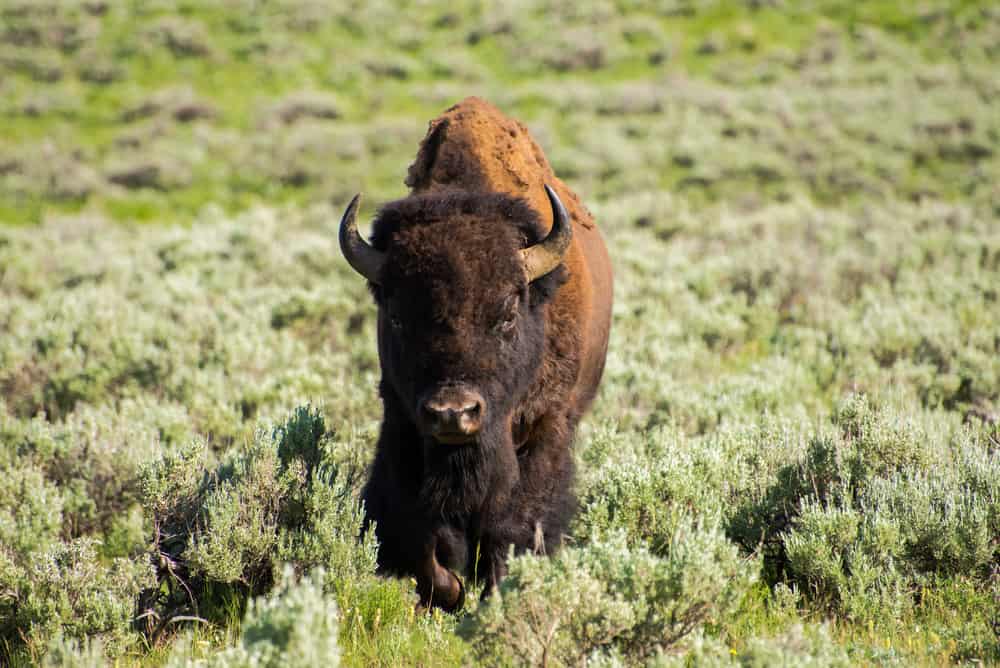
Many animals use the valley as a habitat; grazers come for the vegetation, while carnivores come for the grazers. The National Park Service refers to the Lamar Valley as the American Serengeti in their video Yellowstone in-depth: The Northern Range.
Deer, pronghorn, hundreds of bison, and thousands of elk can be found. Grizzly and black bears, cougars, and wolves are also present. Willow and aspen trees are recovering along the river now that the wolf population has been restored, providing habitat for moose, beaver, and other wildlife.
The Lamar Valley is the ideal site in the park for wildlife viewing because there are so many animals in the area and the ground is flatter and more open. It’s also the best site to see wolves in the world. You can spend a whole day simply photographing and filming the numerous wildlife in Lamar Valley.
Tower Fall
One of Yellowstone’s most stunning and accessible waterfalls is Tower Fall. Tower Creek, just before it meets the Yellowstone River, has a 132-foot fall. It was one of the sites that so moved members of the United States Congress that Yellowstone National Park was founded in 1872.
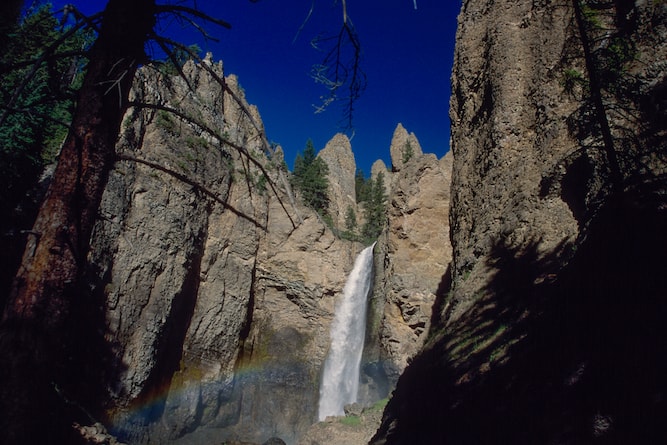
The peak of the fall is named after a collection of granite towers. Wind and water erode the softer rock and soil faster than the harder volcanic rock, resulting in these pinnacle-like towers.
Tower Fall is about 3 miles south of Tower-Roosevelt Junction on Tower Canyon Road. Tower Fall Overlook, which has a fantastic view of the upper part of the falls and the pinnacles at the top, is a short walk from the Tower Fall parking area. The 150-yard path is simple.
There’s also a long road that leads to the Yellowstone River at the canyon’s bottom. The river is visible, but you can’t see or go to the bottom of the falls. A rockslide wrecked the trail and viewing platform a few years ago.
Petrified Tree
It’s difficult to comprehend that anything could be tens of millions of years old. That is the age of the Petrified Tree. This now solid rock was once a massive redwood tree surrounded by a grove of other redwood trees. Mudflows and volcanic deposits swiftly filled the open pores of the tree during furious volcanic eruptions millions of years ago, hardening it into the stony trunk you can see.
There is currently only one petrified tree remaining where there were previously two. Visitors and explorers took portions of the second tree until there was nothing left to take in the park’s early days. The remaining tree is surrounded by a fence, ensuring that it will be left alone and standing for future generations. This geological wonder can be reached through a 1/4 mile paved road that branches off the Grand Loop Road.
Due to a lack of room for trailers and large vehicles to turn around, they are not permitted to drive back to the Petrified Tree. At the beginning of the road, there is a tiny pullout where you may park trailers and heavy cars and then walk less than 1/4 mile to the Petrified Tree.
Mammoth Hot Springs
Since they are unlike any other thermal spot in the area, Mammoth Hot Springs is a must-see attraction in Yellowstone National Park. Because limestone is such a soft rock, travertine can grow significantly more quickly than other sinter forms. It’s been likened to a cave that’s been turned entirely inside out.
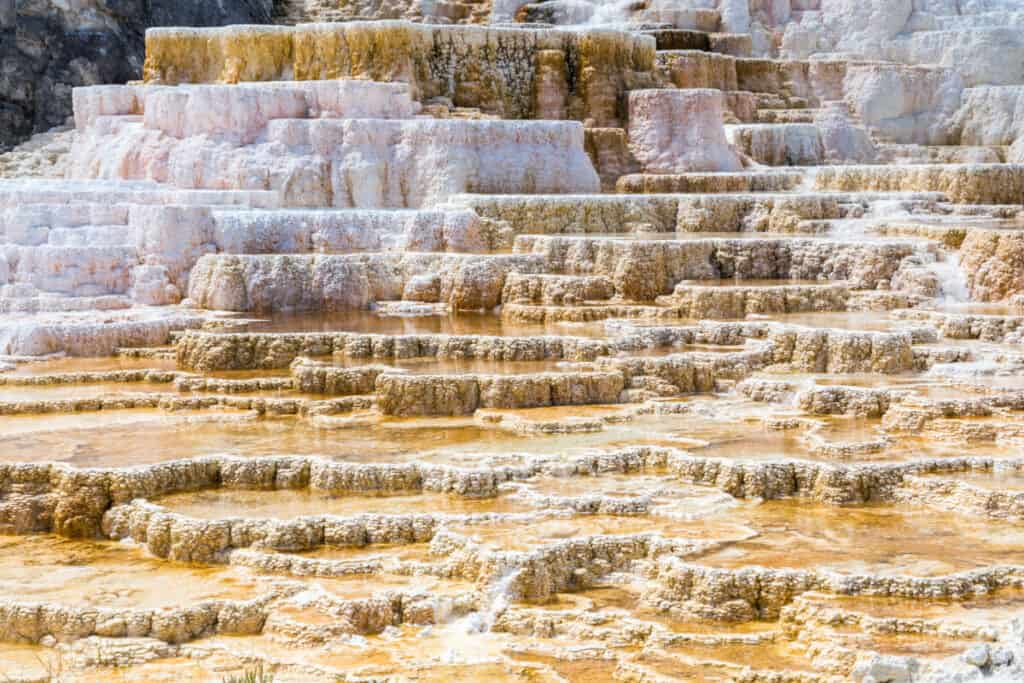
The color you see in hot springs, from Mammoth to Grand Prismatic, is caused by microorganisms called Thermophiles. Orange, brown, purple, and yellow are among the colors used to paint the terraces. Waterfalls cascade down the terraces, creating a one-of-a-kind cascading hot spring experience.
A short walk across the Lower Terraces is the best way to experience Mammoth Hot Springs. The Mammoth area is conveniently positioned near the park’s north gate. They’re a long way from other Yellowstone attractions like Old Faithful and the Lake Hotel, but they’re well worth a visit while you’re there.
Firehole Lake Drive
Firehole Lake Drive is a two-mile one-way road near Yellowstone National Park’s Lower Geyser Basin. This is one of Yosemite’s hidden beauties, where you’ll find privacy and peace. On a busy day, you might see a few people, but you’ll most likely be alone.
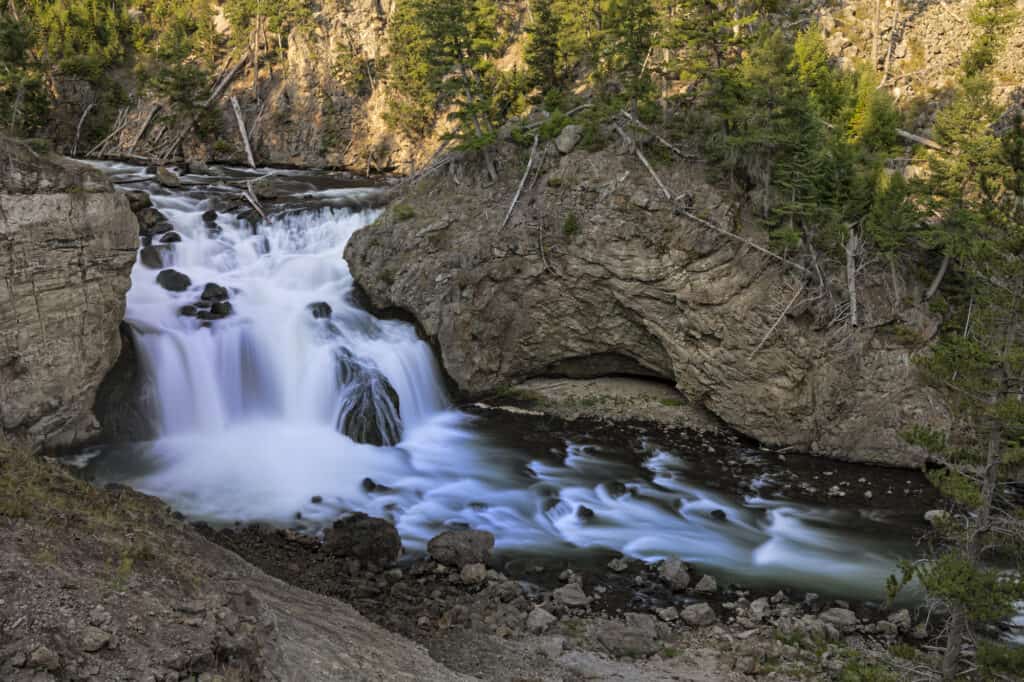
There is enough parking for various distinct thermal characteristics in this area when driving around the loop. You can park in any of the pull-off lots and walk out onto the boardwalks to get a closer look at the thermal features than you might think.
At sunset, photographing here can be challenging. To avoid blowing out highlights in bright sunlight and reflecting water, keep your exposures low. In post-production, recovering dark shadow areas is simple. Foggy days provide a new level of intrigue to the scene.
Firehole Lake, Pink Cone Geyser, White Dome Geyser, Great Fountain Geyser, and several smaller pools and fumaroles are among the notable features that can be photographed.
Grizzly and Wolf Discovery Center
The Grizzly and Wolf Discovery Center is an excellent place to see grizzly bears and wolves in a safe environment. Some of the species are native to Yellowstone National Park, while others come from Alaska. In the wild, all of the animals that live here would be able to survive.
This program gives people a second chance while simultaneously providing educational opportunities for Yellowstone visitors.
Seven bears, five wolves, some birds of prey, and a Karelian bear dog live at the Center. Throughout the year, the creatures can be spotted.
Tickets are valid for two days of admission in a row. As a result, if you stay in West Yellowstone, you’ll be able to see the park twice.
The Grizzly and Wolf Discovery Center is located in West Yellowstone, right beyond the park’s West Entrance. Every day of the year, it is open.
Grand Prismatic Spring
Regardless of the season, the Grand Prismatic Spring is one of Yellowstone’s main attractions as the country’s largest hot spring. In fact, due to the crowds, visiting Grand Prismatic Spring in September maybe even better than coming in the summer.
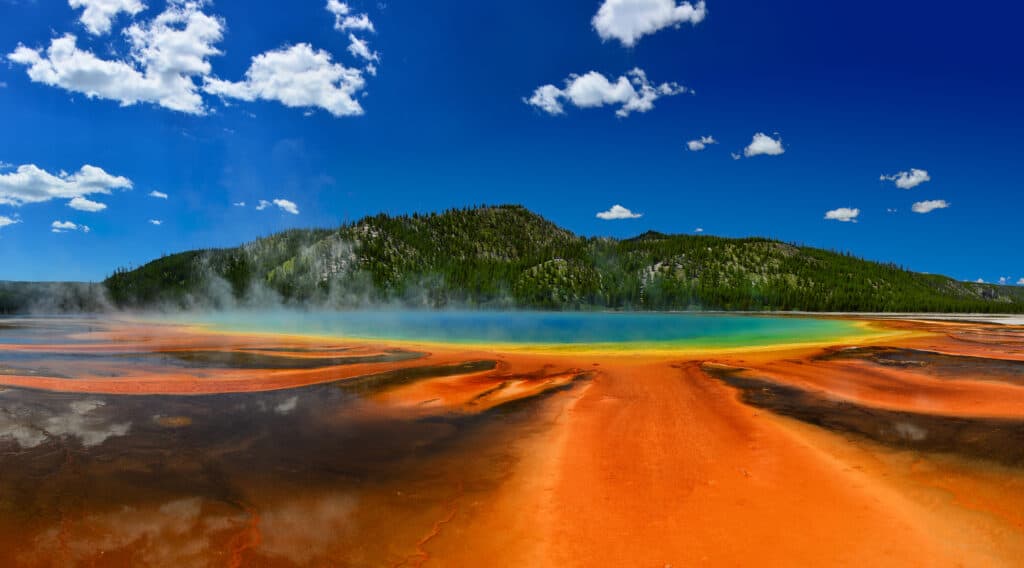
If you visit during the peak season, you may have to wait up to an hour to get a parking spot at Grand Prismatic Spring.
The massive Grand Prismatic Spring is famous for its rainbow-like colors that radiate from the hot spring’s center. These hues are caused by various microorganisms that live in various regions of the spring and are one of nature’s most amazing phenomena.
Old Faithful Geyser
There is generally a large crowd at Old Faithful, similar to the Grand Prismatic Spring. That means you’ll be able to visit it more easily in September!
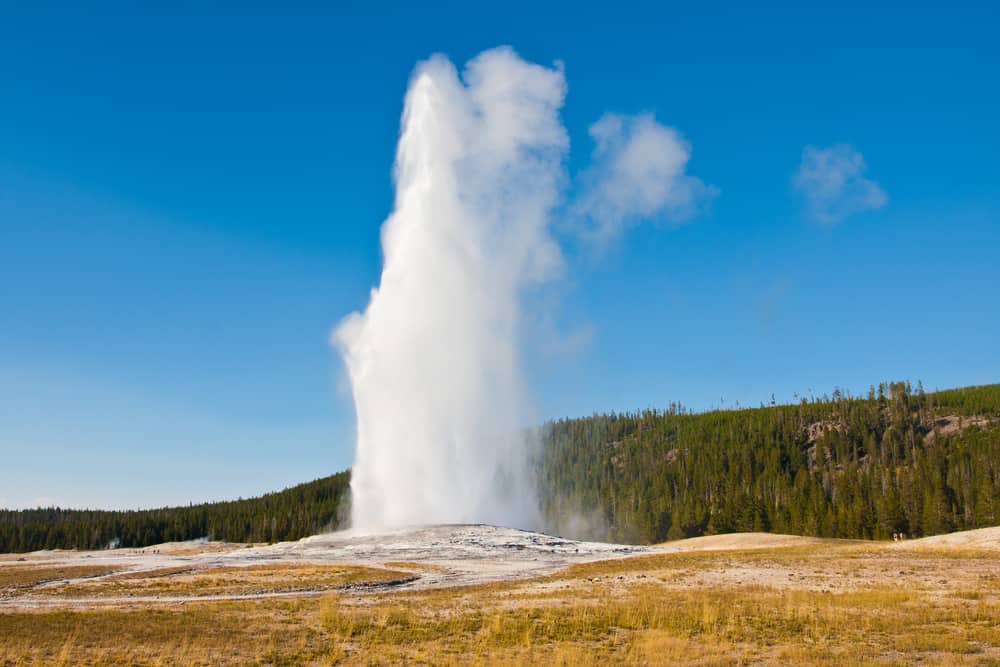
The most well-known geyser in Yellowstone National Park is Old Faithful. Every 60 to 90 minutes, it erupts to a height of roughly 185 feet. While it is not the tallest geyser in Yellowstone National Park, Old Faithful is one of the most reliable huge geysers.
Old Faithful ensures that everyone may see such a spectacular geothermal spectacle with their own eyes.
Grand Canyon of Yellowstone
One of the best sites to visit in Yellowstone in the fall is the Grand Canyon. The Grand Canyon of Yellowstone is a 20-mile-long canyon carved out by the Yellowstone River’s continual erosion. It has two waterfalls.
The Grand Canyon of Yellowstone may easily win any beauty pageant with its white-bleached walls, a sea of lush flora, and the fierce Yellowstone River. The autumn foliage adds to the majestic majesty of the park in the fall. The fields are dotted with vivid autumnal color, and the vista appears as it came straight out of a travel magazine.
Old Faithful Inn
The national historic property Old Faithful Inn was built in 1903-1904 and is one of Yellowstone’s oldest lodges.
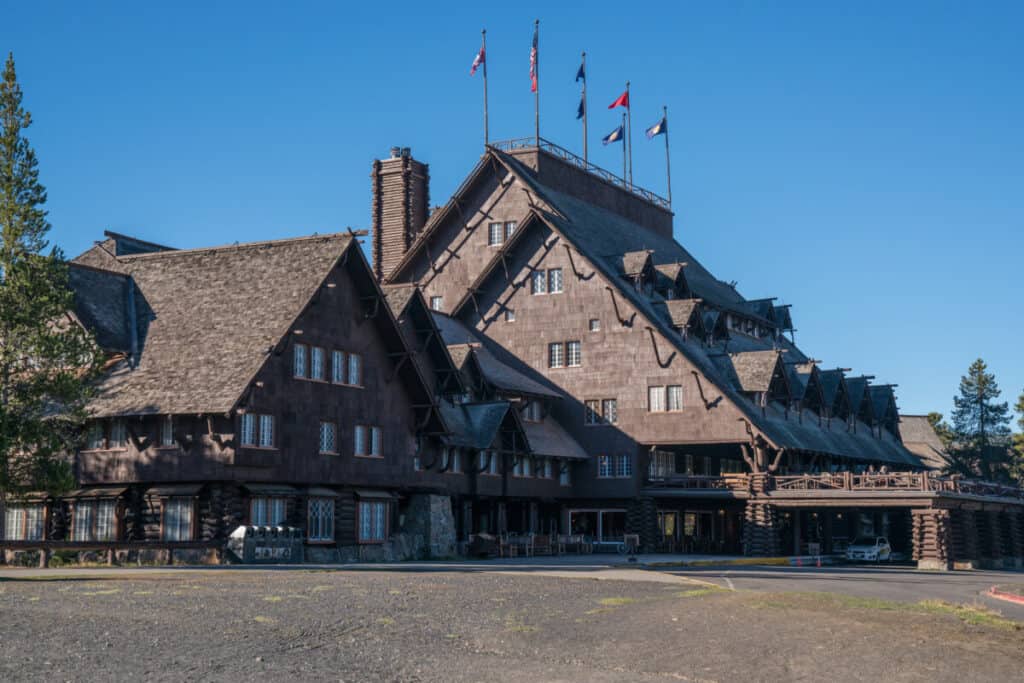
Since it is the world’s largest log construction, the interior of the Old Faithful Inn is breathtaking.
This magnificent edifice may be explored without being a hotel guest. Simply enter the main building and take a look around.
If you’re interested in learning more about the history of the lodge and Yellowstone, you can even join an organized tour. Tours are free and occur numerous times throughout the day; simply sign up for one when you arrive.
Mount Washburn
A hike to the top of Mount Washburn is one of the best things to do in Yellowstone. The views from the top are breathtaking, and if you’re lucky, you might spot some bighorn sheep or bears (bear spray is recommended if trekking in Yellowstone’s more remote areas!).

Mount Washburn is not for the faint of heart, since it requires a strenuous ascent of roughly 2-3 hours one way.
Bring a picnic lunch and plenty of water. It’s a good idea to carry a jacket because it can get quite windy and cold up there. Arrive early because parking is limited at both trailheads.
Norris Geyser Basin
One of Yellowstone National Park’s hottest and most acidic hydrothermal locations is the Norris Geyser Basin, which is part of one of the world’s largest active volcanoes.
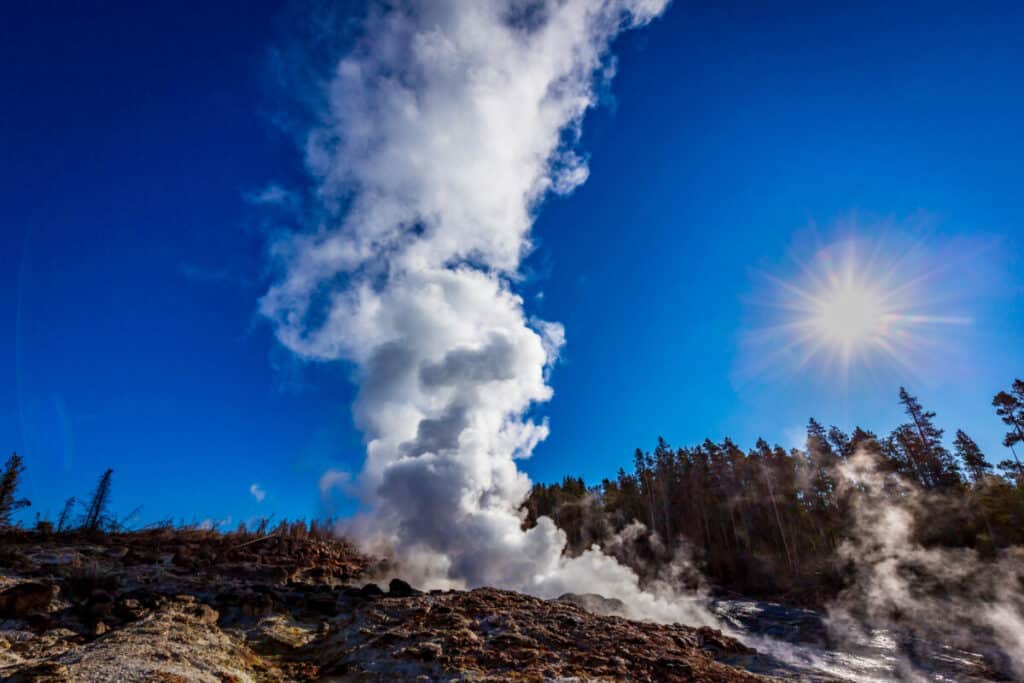
The geysers and features of the Norris Geyser Basin are constantly changing and altering because of seismic activity along the fault lines that run through it. It’s noted for having the oldest, hottest, and most active hydrothermal zones in Yellowstone.
Porcelain Basin and Back Basin are two adjoining basins that make up the Norris Geyser Basin. Both are only accessible from the Norris Geyser Basin parking area through the boardwalk trails.
In addition to seeing the geysers, the basin’s mix of materials creates a kaleidoscope of colors and provides a quiet habitat for species such as deer and bison. The Norris Museum has more information on these fascinating hydrothermal properties. So, make sure to visit the museum.
Yellowstone Grand Loop Road
The Grand Loop is the main road in Yellowstone National Park. This scenic walk is one of the best things to do in Yellowstone.
On a map of Yellowstone, you’ll see that the main highways form an 8-shape that connects all of the park’s must-see sites. If you travel the entire scenic loop, you’ll pass all of the major Yellowstone attractions except the Lamar Valley.
The Grand Loop is around 142 miles (230 kilometers) long, and depending on traffic, it can take anything from 4 to 8 hours to complete.
You can drive the Lower Loop and stop at the major sights if you just have one day and are short on time.
Trout Lake Trail
Trout Lake Trail is a 1.2-mile loop that is mainly flat and well-maintained, making it excellent for small children or older family members with restricted mobility. It is located 30 miles northeast of Mount Washburn. Additionally, just because it’s short doesn’t mean it skimps on scenery.
Trout Lake has a soothing ambiance. Hikers will pass through a forest on their way to Trout Lake, which is surrounded by lush vegetation, including Douglas fir trees and cliff walls.
Trout Lake Trail has no set hours, and access is included in your park admission fee. Bear spray is recommended because there is a bear activity in the area, according to the National Park Service.
Lone Geyser Trail
This is a flat, paved trail that follows the Firehole River to a woodland clearing where the Lone Star Geyser, an impressive thermal phenomenon, may be found.
The journey’s highlight is a 12-foot-tall mound of geyserite with thin ribbons of thermophilic discharge adding to its grey and cream-colored palette. It’s much more stunning if you can catch one of the geyser’s regular 30 to 45-foot explosions.
The route is a multi-use path with tarmac sections here and there but is mostly packed gravel. It appeals to both bikers and hikers. The entire course runs alongside the river, with some beautiful views of the meadows along the way. The major draw, though, is the geyser, which has benches and a logbook to keep track of outbursts.
On average, Lone Star erupts every three hours. It’s not unusual for a little eruption to last a few minutes and shoot roughly 40 feet above the cone. The geyser then goes silent for about 20 minutes before resuming its main eruption. Steam and water shoot 40 to 50 feet for 20 to 30 minutes, culminating in a very loud steam eruption with incredible energy.
September in Yellowstone National Park
September is also a fantastic month to visit Yellowstone. Many species of wildlife are mating, which means that you can observe them in almost every part of the park. In September, hiking and backpacking are at their best, with the aspen trees gleaming gold in the autumn sunshine, turning even a short trek into something magnificent.
In addition, fishing is excellent in many rivers in September, when the water cools and the trout resume their feeding habits. In September, there’s enough to do in Yellowstone to make your trip unforgettable!
Finally, September is a fantastic month to visit Yellowstone for hiking and backpacking! The bugs are gone, the crowds have mainly dispersed, the weather is still pleasant, and the backcountry is ready to be explored.
Recent Posts
15 Tips for Visiting the Grand Canyon in September – 2023 Ultimate Guide
Visiting the Grand Canyon in September is a great time to visit. September is a busy time to visit but the crowds are starting to arrive especially toward the end of the month. I’ve included...
15 Tips for Visiting the Grand Canyon in August – 2023 Ultimate Guide
Visiting the Grand Canyon in August is a great time to visit. August is a busy time to visit but the crowds are starting to arrive especially toward the end of the month. I’ve included all...
